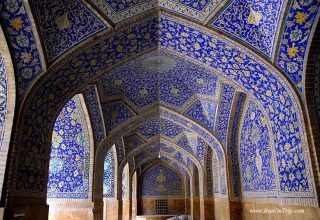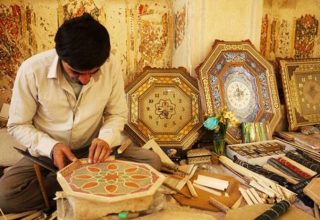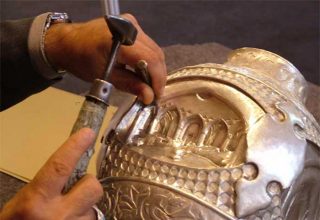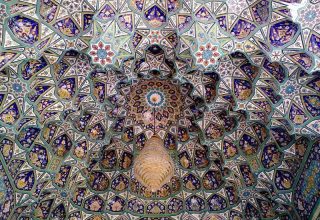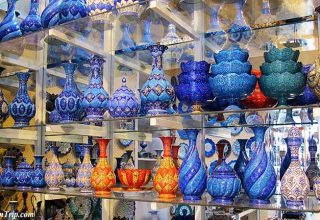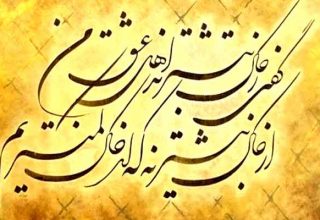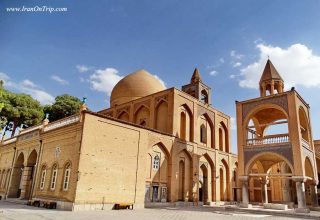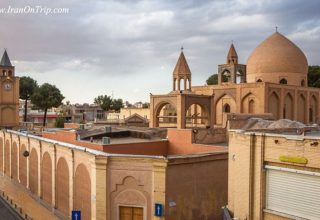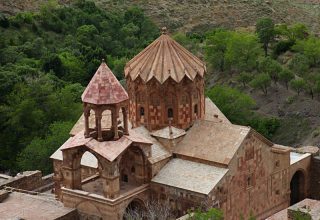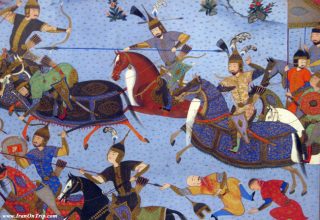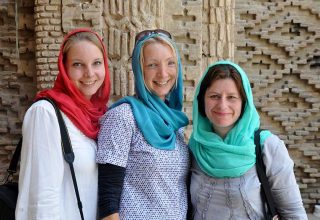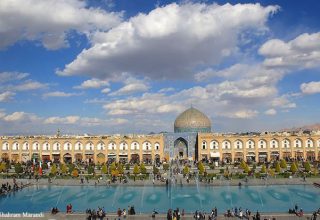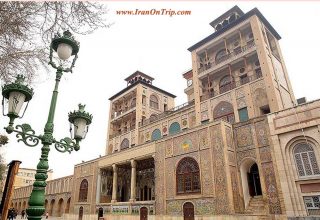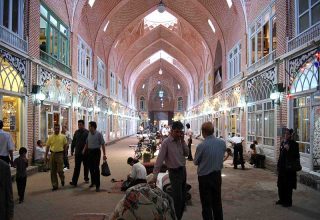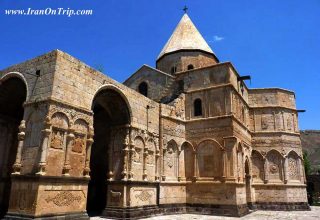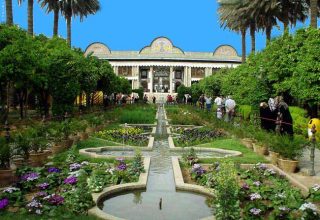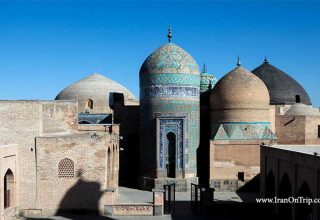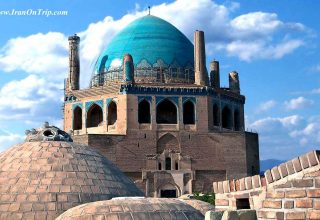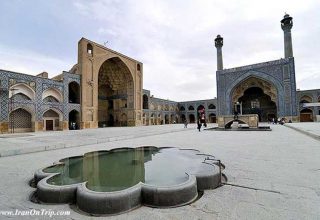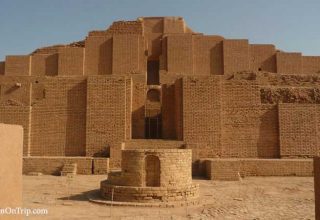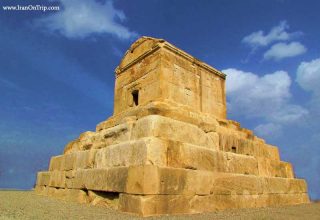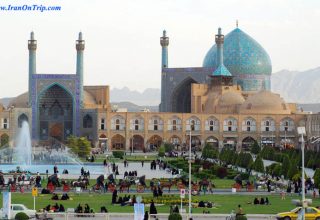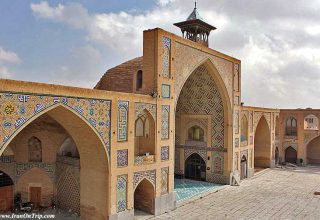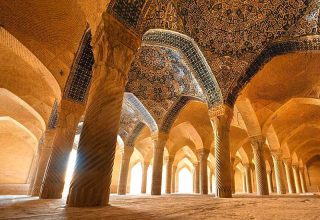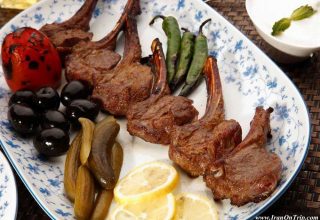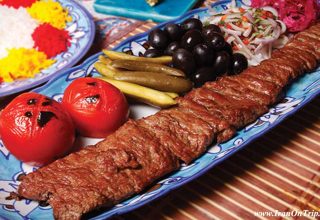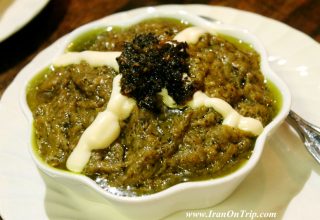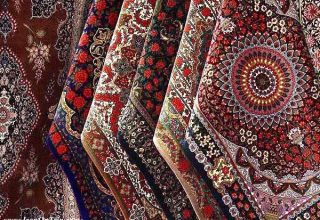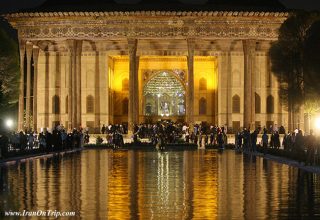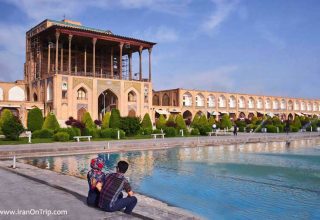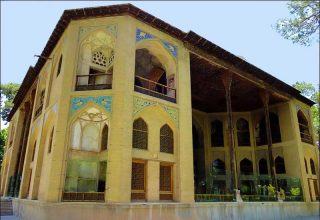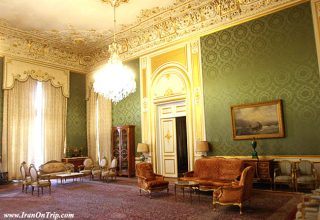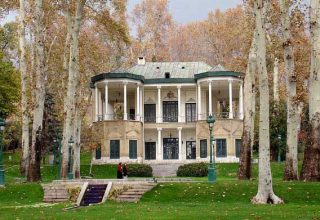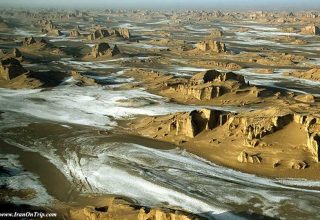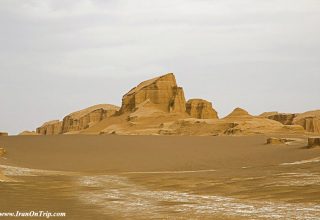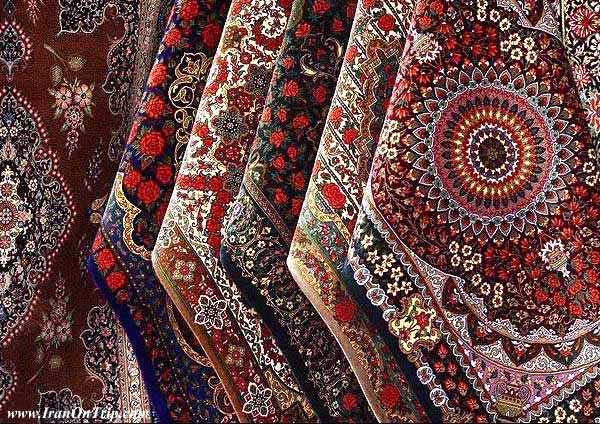

Introductory survey of Persian carpet
The history of Persian carpet manufacture is fraught with unproved hypotheses, rash assumptions, and confident assertions that flout historical evidence. Indeed, scholars hold widely differing opinions on almost every aspect of the production of Persian carpets. As Edward Gibbon said in another connection, “the melancholy duty is imposed upon the historian” of trying to determine what facts are beyond dispute.They are few.

The discovery of the Pazyryk carpet and an even earlier fragment in tombs in Siberia revealed that the manufacture of knotted-pile carpets is of far greater antiquity than had previously been supposed.The oldest previously known pile carpets were manufactured in Anatolia in the 7-8th/13-14th centuries .With the exception of several fragments from Sasanian levels at Shahr-e Qumis and possibly of a fragmentary lion carpet recently purchased by the De Young Museum in San Francisco no Persian pile carpet can definitely be said to survive from before the 10th/16th century . There is literary evidence for the existence of carpets in western Asia from pre-Islamic times , but it is impossible to say whether or not they were knotted. The famous jeweled garden carpet of Ḵosrow I at Ctesiphon was almost certainly not a pile carpet but a flat weave or an embroidery ; a pile carpet of the size described ( 27 m square) would probably have weighed more than two tons .

According to Kurt Erdmann, Oriental carpets were not regularly imported into Europe before the end of the 7th/13th century . At about that time European artists began to depict such carpets in their paintings; Giotto seems to have been the first .Most of the carpets depicted are thought to be Turkish, however, not Persian; it was generally quicker, easier, and cheaper to import carpets into western Europe from Anatolia than from Persia as, especially during the Safavid period, the Ottoman empire, which controlled the traditional overland routes from Persia to the west, was periodically at war with the Persian state. Carpets of presumed Persian design are nevertheless to be found in the paintings of Mantegna (1435-1506), Van Dyck (1599-1641), and Rubens (1577-1640); in fact, in the 17th century some seventy Dutch artists included representations of Persian carpets in their paintings, mainly types originating in northwestern Persia . Oriental carpets and rugs purchased by Europeans were, of course, often too valuable to be laid on the floor, as had been the practice in the Orient since earliest times. Terms used in Venetian inventories indicate that Oriental rugs were placed on tables (tapedi da desco; tapedi da tavola) and on chests that also served as seats , and European paintings confirm such uses.

Beginning with the Safavid period large quantities of pile carpets survive, but the dating and attribution of these and later examples to particular weaving centers are pitfalls for the unwary . Some general observations are relevant, however. First, of an estimated total of between 1,500 and 2,000 surviving Safavid carpets only five are dated .The number is greater from the Qajar and Pahlavi periods , yet, even when a carpet is dated, careful examination is necessary to ensure that the date has not been tampered with . Carpet inscriptions can nevertheless provide invaluable information on craftsmen, places of manufacture, patrons, and so on; furthermore, once a particular carpet has been firmly fixed in time and place, it can be used to identify other structurally related pieces . Arthur Upham Pope pointed out that parallel designs can frequently also be found in architectural decoration, which can be useful in dating and localizing carpets .

The attribution of a carpet made before the late 13th/19th century to a particular place of manufacture is even more hazardous than dating. Friedrich Spuhler declares bluntly that assumptions about the origins of Safavid carpets “which have gained credence over the years are purely hypothetical” , and E. Gans- Ruedin concurs: “Too few written sources are at our disposal today to enable light to be thrown upon the making of any given carpet. For this reason, the method of attribution to a specific production center, used for more than half a century, with a few exceptions, is unreliable. Perhaps the time will come when documents will come to light which will allow us to ascertain the exact provenance of some rugs from the 16th and 17th centuries. Meanwhile, it is possible to formulate hypotheses only” . In the few instances in which a master craftsman has woven his name into the carpet, it would be rash to assume that his nesba (attributive name) indicates the place where the carpet was manufactured. Yet only recently have scholars become more conservative about attributing specific carpets to specific manufacturing centers .
On the other hand, the location of the principal centers of carpet production during the Safavid period and later is generally known from contemporary texts and travelers’ reports, even though it is usually not possible to associate particular carpets with them. It seems generally accepted that it was the Safavids who raised the status of carpet weaving in Persia from a nomadic and rural craft to a national industry, the products of which constituted a significant item of export to India, the East Indies, the Ottoman empire, and Europe. Nor is there much doubt that it was the Safavids who established the first independent carpet factories in some of Persia’s major urban centers .
It is not reasonable, however, to postulate that the Safavid carpet masterpieces came into being ex nihilo. Spuhler raises the pertinent question of why no definitely Timurid carpets, or even carpet fragments, are extant . He points out that the Milan hunting carpet, possibly dated only a few years after the Uzbeks had brought Timurid rule to an end in Transoxania and Khorasan , is in excellent condition and speculates that perhaps some “early Safavid” carpets are really “late Timurid” carpets. Although Spuhler’s hypothesis cannot be proved, the current consensus is that Erdmann went too far in claiming that Safavid carpets represent a complete break from previous knotted pile carpets . Beattie has found design elements on floor coverings depicted in miniature paintings of the 9th/15th century and earlier that portend those of Safavid carpets, including hints of Chinese influence . Leonard Helfgott’s verdict is “Whether or not a transitional period in carpet production preceded this fusion [of carpet-weaving skills with designs from the arts of the book, ceramics, and textiles], or whether this fusion began in a primitive state as a result of contacts with urban culture, or existed as a tendency or undercurrent as a result of Chinese influence, is impossible to determine at this time”
It is possible that Tabrīz was the principal center of carpet production during the early 10th/16th century, for Shah Esmāʿīl I (907-30/1501-24) was initially master only of Azerbaijan; it required ten years of hard fighting to bring the rest of Persia and Mesopotamia under Safavid control. The process was completed only with the capture of Herat in 916/1510.There is no agreement among scholars, however, as to whether or not Esmāʿīl or his successor, Shah Ṭahmāsb (930-84/1524-76), established a carpet factory at Tabrīz, the first capital of the Safavid state. Esmāʿīl is known to have assembled there an array of men skilled in the arts of the book: calligraphers, illuminators, and miniature painters. A major category of Safavid carpets is that known as “medallion” carpets (naqs-etoronj, toronj-dār;), for which, according to Pope, the “most immediate and exact models . . . are to be found in book covers . . .” Both bookbindings and carpets were frequently designed by the illuminators of manuscripts . But did Esmāʿīl establish a carpet factory at Tabriz? Edwards thought that the shah’s military preoccupations precluded such a move, though he admitted the possibility that Ṭahmasb might have done so . Maurice Dimand, on the other hand, categorically states, on stylistic grounds, that “All these early medallion rugs may be assigned to northwest Persia, particularly to Tabriz, the Safavids’ main artistic center” . He also assigned the Milan hunting carpet and the “Emperor’s carpet” in Vienna (and its companion piece, now in The Metropolitan Museum of Art, New York; ) to Tabrīz in the period of Shah Esmāʿīl . Ṭahmasb, is known to have been personally interested in the technicalities of carpet production, for example, details of dyeing, design, and weaving, and is personally credited with having created some carpet designs . Furthermore, Dimand claimed that the Ardabīl carpets, which were woven during his reign, must have come from a Tabrīz workshop There is thus a strong possibility that there was a carpet factory at Tabriz, but, if so, production must have been interrupted by the Ottoman invasions of Azerbaijan and brief occupations of Tabrīz in 940/1533-34, 941/1534-35, and 955/1548 .
In 955/1548 Ṭahmāsb relocated the Safavid capital from Tabriz to Qazvīn, and presumably the production of carpets under royal patronage was also moved. The Safavid court remained at Qazvīn for fifty years until it was transferred to Isfahan by Shah ʿAbbās I in 1006-07/1598. N. Aram-Zanganeh claims that the royal workshops were moved from Tabrīz to Qazvin to Isfahan as each city successively became the capital, which is what would be expected, but Erdmann noted that “the manufacture of carpets at Qazvīṇ . . . cannot be authenticated” . The Hungarian ambassador to the court of the Ottoman sultan Solayman reported the arrival in 975/1567 of gifts from Shah Ṭahmāsb, which included carpets made in Hamadān and Dargazīn; no mention was made of carpets from Qazvīn . The Spanish traveler Father Florencio del Niño Jesús reported that in the early 11th/17th century there was an abundance of silk and brocade carpets at Qazvin .
On the basis of textual sources and travelers’ reports most authorities seem to agree that there were royal Safavid carpet workshops at Isfahan, Kāšān, and Kermān .On the basis of Jean Chardin’s report of thirty-two royal workshops (boyūtāt-e ḵaṣṣa-yesarifa, boyutat-e salṭanatī) employing an average of 150 craftsmen each, the total number employed in such workshops has been estimated at approximately 5,000 .Of course, members of many different crafts and trades were employed in these workshops, and the number of weavers may have been quite small. The workshops not only produced luxury carpets for the Safavid shahs’ mosques and palaces, for gifts to neighboring rulers like the Ottoman sultan, and for the export trade; they also fulfilled commissions from members of the nobility and other private citizens. In at least one instance toward the end of the 11th/17th century the court seems to have contracted out the production of carpets and other textiles to specialized craft guilds, a process known as taḥwīl-eaṣnāf. The shah or another client put up the capital in the form of raw materials and paid weavers regular wages while work was in progress. Sometimes the malek al-tojjār (state supervisor of textile guilds) played this role

At Isfahan the royal carpet workshops were located between the Cehel Sotūn and the Meydān-e Šāh . Father Tadeusz Krusiński, who was in Persia in 1116-42/1704-29, reported that rugs were made there for the royal Court ,Tavernier had observed the same in the late 11th/17th century .According to Florencio, Shah ʿAbbās I, like his grandfather Ṭahmasb, was personally interested in the carpet industry and was himself skilled in carpet weaving , and it would therefore be expected that the volume of carpets produced under royal patronage in Shah ʿAbbās’ reign would at least equal that produced under royal patronage during the reign of Shah Ṭahmāsb. Yet few major authorities are prepared to attribute to Isfahan the manufacture of even such a major category as the “vase carpets” (ṭarḥ-e goldani, goldan-dar;).
Father Krusiński also mentioned Kasan as one of the cities in which royal carpet workshops had been established by Shah ʿAbbas. In 1601 Sigismund III Vasa, king of Poland, sent his purveyor Sefer Muratowicz there with instructions to order several rugs for the king and to superintend their weaving personally (for extracts from Muratowicz’s own report of his journey, see Mańkowski, ). At about the same time several Spanish Carmelites described Kāšān as a center of fine weaving of carpets in silk and gold .Kermān was another city of royal workshops, according to Father Krusiński . Engelbert Kaempfer saw woolen carpets with animal designs from there in the royal palace in 1095/1684.
There was a flourishing export trade in carpets to Europe (sometimes via the Portuguese colony of Goa) and to the Mughal empire, where Safavid exports stimulated the local carpet industry; in effect, some Mughal products were almost “indistinguishable from Safavid carpets”. Some Safavid carpets were regularly shipped by the Dutch East India Company to Batavia, Ceylon, Malaysia, the Coromandel coast, Bengal, and Cochin, as well as to the Netherlands itself . Apart from luxury carpets, which in London might cost as much as 100 pounds sterling for a pair, smaller carpets, in the 7-15 pounds sterling range, were sold there in 1685 and 1688 . In general, however, trade between Persia and the Indies was more reliable and more profitable than trade between Persia and Europe; Persian exports could be shipped to Europe via the overland route through Ottoman territory but only when the Ottomans and the Safavids were not at war. Safavid foreign trade was almost exclusively in the hands of Armenians, who had established businesses in Livorno, Venice, and Amsterdam. The commercial and financial expertise of the Armenians and their European contacts was essential to Shah ʿAbbās’s policy of expanding overseas trade.
Although the Safavids thus transformed a simple rural craft into a courtly art , carpets did continue to be produced by nomadic tribes and in smaller urban workshops. This production continued after the overthrow of the Safavids by the Afghans in 1135/1722 and the consequent decline of the luxury carpet industry, which had depended in large part on royal patronage. Nevertheless, there is some evidence that both Nāder Shah and Karīm Khan Zand commissioned carpets in southern Persia . The breakdown of social and political institutions resulting from a half century of civil war between the Zand and the Qajars also affected the functioning of the economy. Law and order, especially security on the roads, which had played such an important part in encouraging the movement of commercial caravans in the time of Shah ʿAbbās I, could no longer be maintained. With the establishment of the Qajar dynasty in 1212/1797, the carpet industry began to flourish once more, largely owing to local financing and domestic market demand . By the middle of the 13th/19th century carpets of fine quality were being manufactured in a number of centers, as well as by several nomadic groups . The number of Persian carpets exported, however, remained small; it may have been the fortuitous conjunction of two factors, Persia’s need for an export commodity to substitute for silk and strong European demand, that produced a boom in Persian carpets at the end of the 13th/19th century.
Between 1281/1864 and 1284/1867 the silk-worm disease pébrine reached Persia from Europe and caused a drastic slump in Persian exports of raw silk . According to the British consul in Tabrīz in 1289/1872 “the trade of Persia fell to the lowest point since commerce first seriously attracted the attention of foreign merchants.” Many Persian firms were bankrupted.The subsequent sudden rise in European demand was stimulated particularly by the Vienna Exhibition of 1873, where carpets from Khorasan, Farāhān, Senna (Sanandaj), and other cities were exhibited .Furthermore, the rise of the middle class in Britain and elsewhere increased the size of the potential market.
In 1294/1877 the Manchester firm Messrs. Ziegler and Co., which had been importing silk through its agents in Tabrīz, Isfahan, and Tehran, opened a new branch in Solṭānābād (Arāk) for the manufacture of carpets, which soon became “the centre of the carpet trade in Western Persia” .A rival British firm, Hotz and Co., also established a carpet factory there, and by 1296/1879 the carpet boom was well under way. At the same time an agent of the Paris department store Maison du Louvre was making annual visits to Persia for the purpose of buying carpets, and Persia was also beginning to export to the United States .
By 1310/1892, according to Lord Curzon , Persian carpets had “attained so wide a celebrity that the upper-class householder in England or America is rare who does not think the acquisition of such an article, whether genuine or spurious, an indispensable testimony both to culture and to civilisation.” Carpets of good quality were manufactured in the districts of Qaʾen and Bīrjand and Qohestān; at Saraḵs in Khorasan; in the districts of Qaradag and Farāhān in Azerbaijan; in Kurdistan; and in Fārs, where carpets were made at Shiraz and tribal rugs woven by the QasqaʾI . The boom in carpet production was particularly noticeable at Kermān . Whereas “in 1871 there were only six carpet-weaving establishments in the city, and fewer than thirty looms”—there were
probably no more than one hundred looms operative in the whole country at that time —“by 1900 Sykes found over one thousand looms in Kirman City alone, each supervised by a master weaver” . Unfortunately, in an effort to keep up with European demand, Persian carpet manufacturers made the nearly fatal mistake of introducing the use of chemical dyes , and, though the Persian government banned their use in 1304/1877, they continued to be smuggled in, to the detriment of the industry . The late Qajar period was thus characterized, on one hand, by general deterioration in the quality of carpets, resulting from the use of aniline dyes and from hasty production methods introduced by manufacturers eager to meet the demand of foreign markets, and, on the other, by production of sumptuous silk carpets, the like of which had not been seen since the 11th/17th century . High-quality carpets were frequently commissioned by members of the Qajar nobility and of the upper classes generally . Even in the last quarter of the 13th/19th century, however, Safavid carpets still had an overwhelming impact on those who saw them for the first time. William Morris, writing to a friend in 1877, reported: “I saw yesterday a piece of ancient Persian, time of Shah ʿAbbās . . . that fairly threw me on my back; I had no idea that such wonders could be done with carpets” .

The Persian carpet industry has had a checkered history since its resurgence in the last quarter of the 13th/19th century . Not surprisingly, the two world wars represented periods of decline. Persia, caught up in both conflicts by reason of its geopolitical situation, twice experienced loss of foreign markets and resulting severe impairment to domestic prosperity. Furthermore, prophets of doom confidently predicted that the introduction of machinery would put an end to the carpet industry . Nevertheless, by the mid-1920s Persians were again producing “sound and attractive carpets,” and, until the occupation by Allied forces in 1320 S./1941, “the standards of production were, on the whole, well maintained” . With the accession of Reżā Shah (1303 S./1924), royal patronage was resumed, and the industry once again produced carpets that could be compared, in beauty and delicacy of design and finesse of weave, to the finest productions of the 10-11th/16-17th centuries. Some of the carpets woven at the famous Amoḡlī factory in Mašhad actually surpassed the finest extant Safavid carpets in density of knotting. For example, two Mašhad carpets of 1309 Š./1930, with 906 knots to the square inch, and another of comparable quality made in 1314 s./1935 can be compared to a fine Safavid carpet, for years considered to have a silk pile because its knotting is so dense, which has only 822 knots to the square inch .
By 1327 S./1948, however, the Persian carpet industry was once more in a “hapless state” , and in the following year the government convened a conference in Tehran to draw up recommendations for dealing with the three principal evils that had beset the industry intermittently for the previous sixty years and more: the use of aniline and chrome dyes, a decline in the standard of design, and the use of the joftī knot, which produced a carpet inferior both in beauty and in durability .The remedial measures instituted by the government, together with growing consumer resistance to inferior carpets, once again led to a revival of the industry. Foreign demand for Persian carpets, especially in the United States, continued strong. After 1328 S./1949 there were periods of “intense” carpet production in Kerman, owing primarily to demand from the United States for the very thick rugs known in the market as “American Kirmans” . Royal patronage ensured that some carpets of exceptional technical quality were also produced. Gans-Ruedin mentions, for example, a 1349 S./1970 Isfahan carpet with 710 knots to the square inch, which may be compared with three famous 10th/16th-century carpets, those known as the Ardabīl carpets (400 knots per square inch; Plate CIX in ix, ) and the Milan hunting carpet (367 knots per square inch; Plate CVII in ix,). The establishment of the Carpet Museum in Tehran in the mid-1350s S./1970s contributed to the revival of public interest in this aspect of Persian culture.
All about Persian Carpet ، The Persian Rug , Iranian Rug ، ، Iranian Carpet ، Persian Carpets ، Persian Rug ، Arts of Iran ، Carpets of Iran ، Iran Carpet ، Iranian Arts , Iranian Art – Persian Art – Arts of Iranian – Arts of Persian


